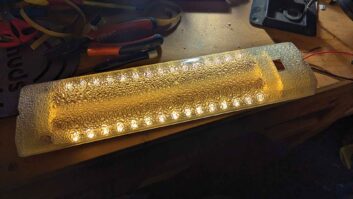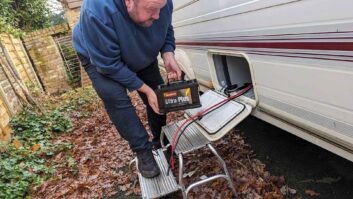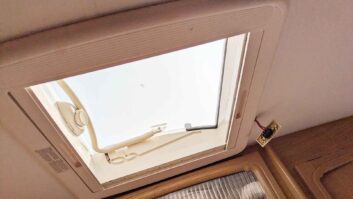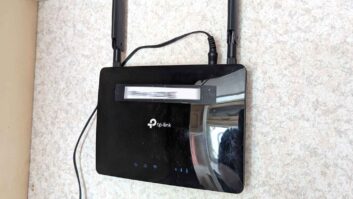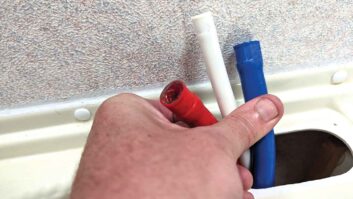If you’ve been following my renovation of Penny, you’ll know I recently discussed the installation of Penny’s new Renogy 500A Battery Monitor and the wiring upgrades needed to support it. With that work all done, it was time to find out what our new toy could tell us as the work continued to get my caravan ready for the touring season.
A battery monitor helps you to keep track of how a 12V caravan leisure battery is performing.
If your van is on a hook-up, the battery status is of no real consequence. Your 12V systems will all work and the charger will keep your battery fit and healthy. But we want to mix up our stops a bit more. We won’t just be staying at the best caravan sites where hook-up will be available, but we want to be able to use Penny to stay on smaller sites and festival fields, going off-grid in comfort. That’s why we have decided to invest in the low-voltage electrics.
Practical Caravan is supported by its audience. When you purchase through links on our site, we may earn an affiliate commission. Learn more
Few vans have sophisticated battery monitoring. Most will only tell you the voltage in your battery: whether, at that moment, you have power in it. Interesting, perhaps, but a proper battery monitor tells you far more. When you are sitting in a dark field with your van lights on, what you really want to know is how much power you’re using and how long you can keep doing so.

With those two pieces of information, you can turn off a few lights to extend battery life, or turn on the TV if you have plenty in reserve.
To avoid being plunged into darkness, a battery monitor is a must. Throw a solar panel and charger into the mix, and you can construct a balanced 12V system that should charge the battery by day and keep the lights on all night if the party really gets going.
The one we chose, the Renogy 500A Battery Monitor, was not the cheapest you can find, at £65, but considering the very valuable service it offers, that wasn’t a vast amount to pay.
There are also quite a lot of companies offering these across the various online retailers, so they can be even cheaper if you are patient and shop around.
The monitor is more than enough for any set-up that you will install in a caravan and as a small, discrete unit, is easy to find the space for.
Its compact display screen has no annoying LEDs to keep you awake at night, and the screen is backlit when in use, so it is usable in the dark.
Key information
The first time you connect it all up, the LCD display provides you with the key information you need to get a full picture of your 12V health. You do need to follow the set-up instructions and in all honesty, they aren’t exactly detailed. I ended up Googling a few of the finer points to ensure we had it all correctly configured.
Setting up
The main things you need to bear in mind are that you have to know the capacity of your leisure battery, and to make sure that it is fully charged.
Using the buttons on-screen, you go into the settings menu and set the amp/hour rating of your battery. Ours is pretty modest at 85Ah, but the Renogy works with battery capacities from one to 9999Ah.
With that saved, the unit will tell you the voltage in the battery, current, the consumed power and the battery capacity.

The display updates instantly, too. Turn off a light, and you’ll see the current consumption drop and the time until the battery discharges recalculated. The little screen is easy to read.
We are already better off than we were before we installed the monitor, even if we make no other changes to the van’s 12V system, because the battery’s state of charge is not a mystery.
Now, however, we can also make more informed decisions on-site about turning devices on and off. In addition, we can measure the effectiveness of any other upgrades we make.
For example, Penny is fitted with tungsten bulbs over the lounge and in the outside lights, along with a host of wheezy old fluorescent lights across the ceiling and the kitchen, and in the washroom.
LEDs are widely regarded as an energy-efficient upgrade, but thanks to the new monitor, we will be able to see exactly what difference each upgrade makes.
Monitoring changes
For example, if we update the battery to a larger one, we’ll be able to see how many more hours of illumination that gets us, and when we add a solar panel, we’ll be able to alter our energy usage, depending on the battery’s state of charge.
It takes some of the jeopardy out of off-grid stays. Yes, some might say it’s a bit nerdy, but I’m a nerd – and I don’t like sitting in the dark! Expect to hear more about our energy usage in the months to come.
Back to the basics
Now, with the prospect of better weather just around the corner, it’s not just the techy upgrades that we need to consider.
Penny may have a shiny new battery monitor, but she has a few more fundamental foibles which really limit our comfort when hitting the touring trail.
Having reinstated the caravan heating system last autumn, we want to reinstate running water next. This needs a little further investigation.
Penny is a caravan from the mid-1990s and the water system she has is standard for a tourer of that era. There’s a submersible water pump connected to the van using a Carver Crystal inlet. The pump is located by two rotating plastic tabs.
The water inlet runs through a filter cartridge, which normally needs replacing annually.
First, let’s get the positives out of the way. Penny still has her submersible pump. That’s important – a replacement is somewhere around £65.
A check with the multimeter confirms that there is power to the water inlet, as well.
But before we get too excited, the water inlet is damaged and at this stage, we don’t know how significant this might be.
There were two main issues. The previous owner told us that the water filter was stuck in the housing. There is some damage to the housing, where attempts to remove the filter have been made, but until we power up the system, we don’t know whether there are any leaks.
The other problem concerns the little plastic locating tabs which hold the water pump connection in contact with the inlet. Anyone who has owned a caravan with this set-up has likely cursed as they struggled to snap them into place. These little tabs, or ‘flags’ as some call them, are prone to jamming or snapping. Penny has one tab snapped off, so we need to think about a solution.
We decided on the ‘cheapest first’ approach. Filtapac sells everything we should need to get things up and running again.
The cheapest fix is a pair of new tabs, which give you change from a fiver. We ordered these, along with a filter cartridge.
Removing the filter
While we waited for the new parts, we set about removing the old filter. The filters screw into position and are designed to be installed by hand.
Once the plastics are a little old and if a few changes have been skipped, they can start to stick. Our was too tight to remove by hand. I needed a little more leverage, so I made a crude removal tool.

I found a length of wastepipe in the garage. I cut a slot in the end of the pipe, which fitted over the end of the filter. I then drilled a hole through the pipe, to allow me to poke a socket extension bar through the pipe, giving me extra leverage.
It worked, too, and the filter came out intact, showing no obvious signs of damage.
The lip surrounding the filter is missing, but it is not near the sealing ring, so when the new parts land, we should be able to get the water running. If we get hot water, we’ll turn our attention to whether the hot water system works.
Don’t forget the smoke alarm
A couple of months ago, we added a carbon monoxide alarm to the caravan after working on the gas system, as a sensible precaution. All caravans should have one.
We already had a smoke alarm fitted, but on closer inspection, it was apparent that it was getting on a bit. It worked when the test button was pushed, but I thought a battery change was overdue. I snapped open the case to get to the battery and was showered in brittle plastic as the catches disintegrated.

A new smoke alarm is not an expensive addition to the caravan budget and I suspect it is the first replacement the van has had in its 26-year life. I picked up a Fire Angel SB1-R and got change from a tenner.
Fitting it was a five-minute job and this one doesn’t explode when you change the battery. It feels like money well spent.
Future Publishing Limited, the publisher of Practical Caravan, provides the information in this article in good faith and makes no representation as to its completeness or accuracy. Individuals carrying out the instructions do so at their own risk and must exercise their independent judgement in determining the appropriateness of the advice to their circumstances and skill level. Individuals should take appropriate safety precautions and be aware of the risk of electrocution when dealing with electrical products. To the fullest extent permitted by law, neither Future nor its employees or agents shall have any liability in connection with the use of this information. You should check that any van warranty will not be affected before proceeding with DIY projects.
If you’ve enjoyed reading this article, why not get the latest news, reviews and features delivered direct to your door or inbox every month. Take advantage of our brilliant Practical Caravan magazine SUBSCRIBERS’ OFFER and SIGN UP TO OUR NEWSLETTER for regular weekly updates on all things caravan related.




















